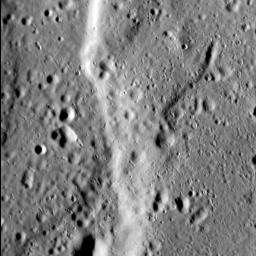In and of itself, this image of a portion of a north-south-trending lobate scarp, situated midway between Firdousi crater and Caravaggio basin, is not particularly noteworthy. Look a little closer, however, and this little part of Mercury's surface takes on a strange, pitted appearance. A number of shallow, teardrop-shaped depressions occur throughout the image, aligned from the top-left to the bottom-right. This distinctive surface texture is likely caused by debris thrown out by nearby impacts (there is a crater 11 km, or 7 miles, in diameter to the southeast that might be responsible, for example). If so, then these small depressions are effectively secondary impact craters-but not quite like those we're used to seeing. The difference between these depressions and what we normally think of as secondary craters is likely due to size: as MESSENGER gets closer to the surface of Mercury, we are seeing more and more fascinating features at ever greater resolutions. What else will we see before MESSENGER's adventure ends?
This image was acquired as a high-resolution targeted observation. Targeted observations are images of a small area on Mercury's surface at resolutions much higher than the 200-meter/pixel morphology base map. It is not possible to cover all of Mercury's surface at this high resolution, but typically several areas of high scientific interest are imaged in this mode each week.
Date acquired: July 31, 2014
Image Mission Elapsed Time (MET): 49172453
Image ID: 6788651
Instrument: Narrow Angle Camera (NAC) of the Mercury Dual Imaging System (MDIS)
Center Latitude: 1.2°
Center Longitude: 77.7° E
Resolution: 23 meters/pixel
Scale: The left-to-right field of view in this image is 21 km (13 miles) across
Incidence Angle: 77.1°
Emission Angle: 1.9°
Phase Angle: 78.9°
North is up in this image.
The MESSENGER spacecraft is the first ever to orbit the planet Mercury, and the spacecraft's seven scientific instruments and radio science investigation are unraveling the history and evolution of the Solar System's innermost planet. During the first two years of orbital operations, MESSENGER acquired over 150,000 images and extensive other data sets. MESSENGER is capable of continuing orbital operations until early 2015.
For information regarding the use of images, see the MESSENGER image use policy.

 Planetary Data System
Planetary Data System












